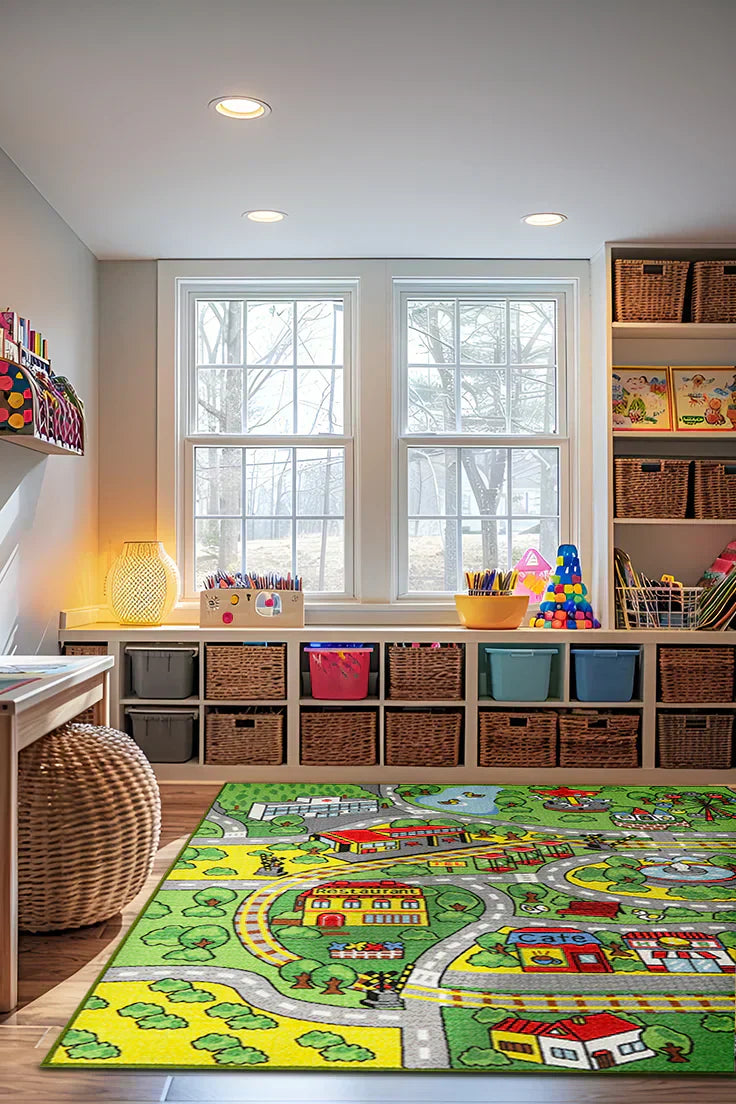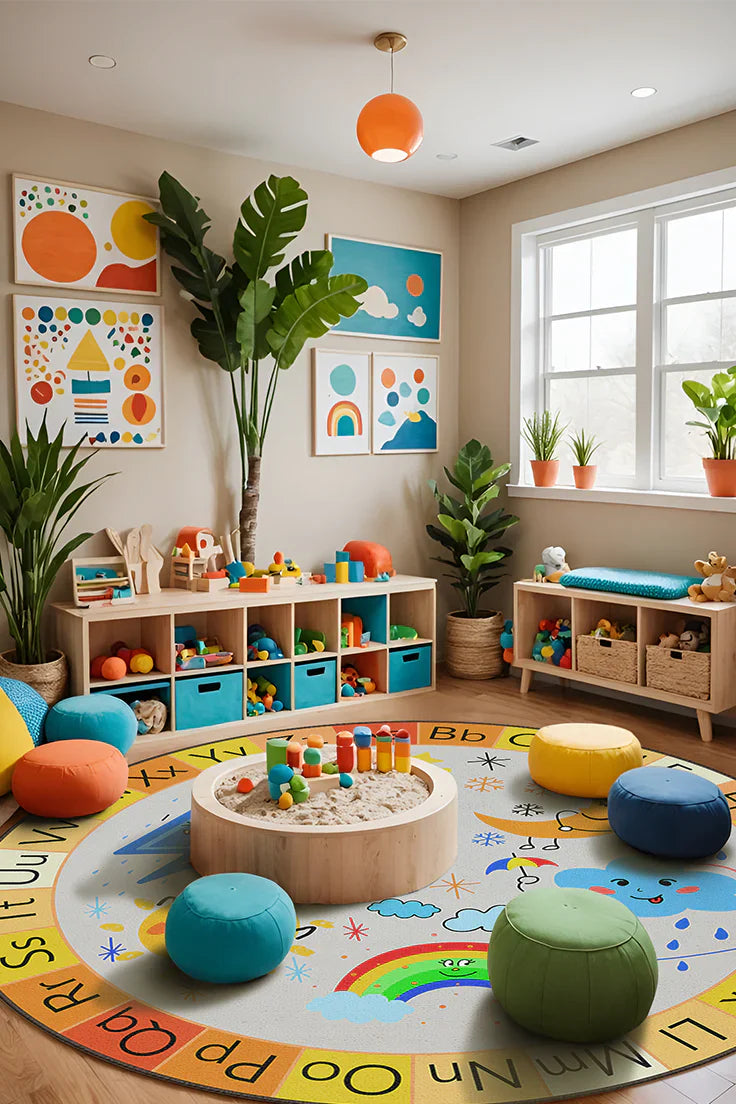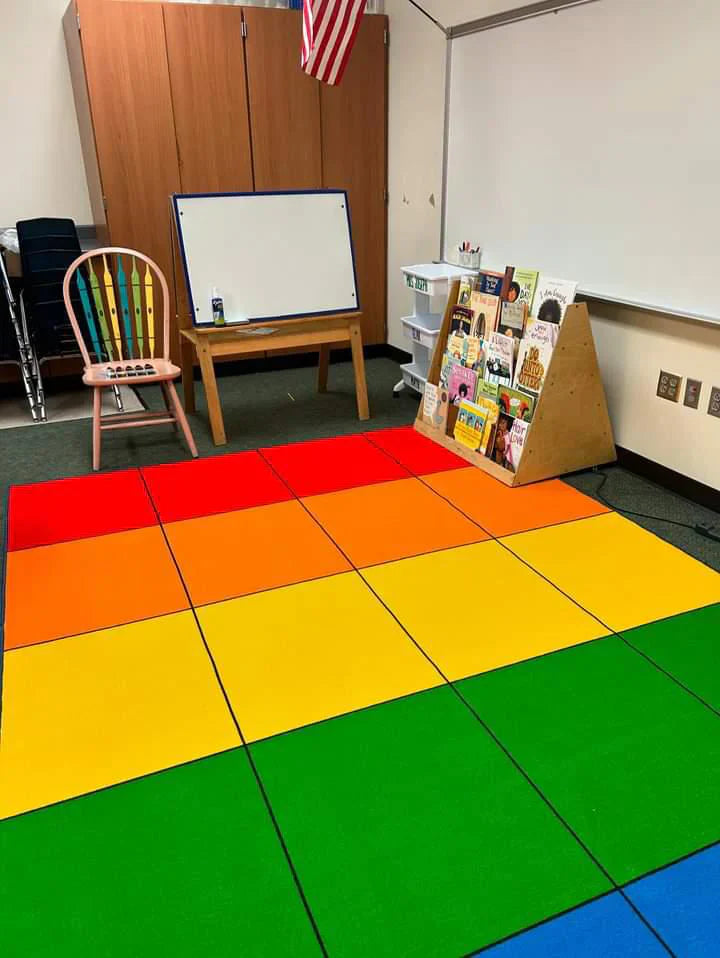The Science Behind Color Psychology in Children
How Children Process Color Differently
Children's brains process colors more intensely than adults, making them particularly sensitive to their colorful environments.
Research published in developmental psychology shows that by age 2-2.5 years, socially constructed color associations begin affecting children's preferences and emotional responses.
Key Developmental Stages:
- Infants (0-12 months): Attracted to high-contrast colors and primary hues
- Toddlers (1-3 years): Prefer bright, bold colors that aid cognitive development
- Preschoolers (3-5 years): Respond strongly to primary colors for learning activities
- School-age (5+ years): Develop more complex color preferences and associations
Neurological Impact of Color Exposure
Studies demonstrate that color exposure affects children's neurological pathways and biochemical responses.
Colors function as wavelengths of energy that can enhance or hinder learning processes, making strategic color selection essential for optimal educational outcomes.
69% of children's emotional responses to color are positive, with bright colors evoking happiness and excitement while dark colors can trigger negative emotions.
This research underscores the importance of thoughtful color curation in learning environments.
Color-Specific Effects on Children's Behavior and Learning
Blue: The Ultimate Learning Enhancer
Blue emerges as the champion of cognitive enhancement in educational settings. Our Nature-Themed Classroom Sensory Rug incorporates calming blue tones that:
- Reduce anxiety and stress in overstimulated children
- Enhance productivity and focus during academic tasks
- Lower heart rate and blood pressure for improved concentration
- Support children with ADHD by providing visual calm
Perfect Applications: Reading corners, quiet study areas, and calm-down zones benefit most from blue-dominant rugs.
Green: Nature's Cognitive Booster
Green represents the most important color students should access in learning environments. Our Farm Scenery Series Educational Play Mat harnesses green's powerful effects:
- Improves reading comprehension through enhanced concentration
- Reduces eye strain during extended learning sessions
- Promotes healing and restoration in stressful situations
- Connects children to nature even in indoor environments
Research shows that exposure to green and live plants positively impacts both visual and verbal creative thinking in classroom settings.
Yellow: The Memory and Focus Amplifier
Yellow stands out as the ultimate attention-grabber that benefits memory and focus. Our ABC Fun Kids Rugs strategically use yellow elements to:
- Boost mood and happiness during learning activities
- Enhance memory retention for alphabet and number recognition
- Increase alertness during morning activities
- Stimulate creative thinking and problem-solving
Caution: While yellow enhances learning, excessive use can lead to overstimulation and decreased concentration.
Red: The Energy and Motivation Catalyst
Red provokes strong emotions and should be used strategically. Our 3D Roadway Kids Rug incorporates red accents that:
- Increase energy levels for physical activities
- Enhance attention to detail during focused tasks
- Boost motivation for challenging learning activities
- Encourage social interaction in group settings
Best Practice: Use red as accent colors rather than dominant hues to avoid overstimulation.
Orange: The Social Confidence Builder
Orange promotes happiness, enthusiasm, and social interaction. Our City Series rugs feature orange elements that:
- Help shy children come out of their shells
- Encourage peer interaction during group activities
- Increase appetite (perfect for snack areas)
- Boost confidence in extroverted children
Purple: The Creative Imagination Stimulator
Purple balances stimulation with calm, making it ideal for creative learning activities. Our classroom rugs incorporate purple to:
- Enhance imagination during storytelling time
- Support artistic expression in creative zones
- Promote deeper thinking and problem-solving
- Create sophisticated learning environments for older children
Global Applications: Regional Color Psychology Preferences
North American Markets
United States and Canada: Schools emphasize bright, engaging colors that support diverse learning styles. Our colorful rugs help teachers create inclusive classroom environments that accommodate:
- ADHD students: Blue and green dominant rugs for improved focus
- Anxiety-prone children: Calming color palettes for emotional regulation
- Culturally diverse populations: Color schemes that avoid negative cultural associations
Case Study: Elementary schools in Portland, Oregon report 35% improvement in student engagement when using strategically colored classroom rugs.
European Educational Systems
Scandinavia and Germany: Emphasis on natural, muted color palettes aligns with outdoor learning philosophies. Our nature-themed rugs support:
- Waldorf education: Earth tones and natural colors for holistic development
- Montessori methods: Organized color systems for independent learning
- Special needs integration: Calming colors for sensory-sensitive students
United Kingdom: Research-driven approach to color psychology leads to strategic rug placement in different learning zones.
Asia-Pacific Region
Singapore and Hong Kong: High-achievement educational cultures benefit from focus-enhancing colors:
- Blue-dominant rugs in academic areas for improved concentration
- Green elements for stress reduction in competitive environments
- Yellow accents for memory enhancement during test preparation
Australia and New Zealand: Outdoor learning integration uses nature-inspired color palettes year-round.
Developing Markets
Latin America and Africa: Vibrant cultural traditions embrace bold, energizing colors:
- Red and orange combinations for community-building activities
- Green and blue balance for academic focus areas
- Cultural color integration respecting local traditions and meanings
Strategic Color Application in Different Learning Zones
Active Learning Areas
High-energy zones benefit from warm color combinations that stimulate engagement:
Recommended Rugs:
- Rainbow Classroom Play Rug: Multi-colored design energizes group activities
- Construction Rug Play Mat: Bold colors inspire building and creation
- City Series Green Roadway: Balanced energy for imaginative play
Quiet Learning Spaces
Calm zones require cool color dominance for focus and relaxation:
Optimal Choices:
- Nature-Themed Classroom Sensory Rug: Peaceful greens and blues
- Ocean Alphabet Educational Rug: Soothing underwater themes
- Simplicity Style Star Seating Rug: Muted tones for concentration
Creative Expression Areas
Artistic zones thrive with balanced warm and cool combinations:
Perfect Solutions:
- Farm Village Series Educational Rug: Natural colors inspire storytelling
- Space Series 3D Planet Kids Play Mat: Cosmic colors spark imagination
- ABC Fun Kids Rugs: Organized colors support creative learning
2025 Color Trends in Educational Design
Trending Color Palettes
Modern classroom design embraces deeper, nature-inspired neutrals:
- Sage Green: Promotes tranquility and focus
- Warm Taupe: Creates grounding, stable environments
- Soft Terracotta: Adds warmth without overstimulation
- Deep Cobalt: Supports emotional intelligence development
Technology Integration Considerations
As digital learning increases, physical color environments become more crucial for:
- Screen time balance: Natural colors provide visual rest from digital stimulation
- Sensory regulation: Tactile color experiences support healthy development
- Focus enhancement: Strategic colors improve attention during hybrid learning
Cultural Sensitivity in Color Selection
Avoiding Color-Related Bias
Understanding cultural color associations prevents unintended negative impacts:
Global Considerations:
- White: Purity in Western cultures, mourning in some Eastern cultures
- Red: Good fortune in Asian cultures, danger in others
- Black: Sophistication in some contexts, negativity in others
- Gender neutrality: Moving beyond pink/blue stereotypes
Inclusive Design Principles
Our rug collection supports inclusive environments through:
- Diverse color representation avoiding cultural stereotypes
- Universal calming colors that transcend cultural boundaries
- Balanced palettes supporting all learning styles and backgrounds
Practical Implementation: Creating Color-Balanced Classrooms
Assessment Strategy
Before selecting classroom rugs, evaluate:
- Student demographics and cultural backgrounds
- Learning objectives for different classroom areas
- Natural lighting and existing color elements
- Special needs considerations for sensory-sensitive students
Color Balance Guidelines
Effective Classrooms Feature:
- 60% neutral or calming colors (blues, greens, soft neutrals)
- 30% energizing colors (warm yellows, oranges)
- 10% accent colors (strategic reds, purples)
Rotation and Adaptation
Consider seasonal color adjustments:
- Fall: Warmer colors for energy as daylight decreases
- Winter: Brighter colors to combat seasonal mood effects
- Spring: Fresh greens and blues for renewal and growth
- Summer: Calming colors for end-of-year focus
Safety and Quality: Color That Lasts
Material Excellence for Vibrant Colors
Booooom Jackson ensures color psychology benefits through:
- Fade-resistant printing: High-definition colors maintain psychological impact
- Non-toxic dyes: OEKO-TEX® certified materials safe for children
- Easy maintenance: Colors stay vibrant through regular cleaning
- Durable construction: Long-term color integrity for sustained benefits
Testing and Certification
All our rugs meet rigorous standards ensuring:
- ASTM International approval for child safety
- CPSC certification for consumer protection
- Hypoallergenic properties for sensitive children
- Environmental safety through eco-friendly materials
Investment ROI: The Long-Term Impact of Strategic Color Choices
Academic Performance Benefits
Schools investing in color psychology report:
- 15-25% improvement in student focus and attention
- Reduced behavioral incidents through environmental calming
- Enhanced creative output in arts and writing activities
- Improved test scores in color-optimized learning environments
Teacher Satisfaction Metrics
Educators in color-strategic classrooms experience:
- Reduced stress levels through environmental harmony
- Improved classroom management via behavioral color cues
- Enhanced teaching effectiveness through student engagement
- Increased job satisfaction in pleasant environments
Conclusion: Transforming Learning Through Color Intelligence
Color psychology represents one of the most powerful yet underutilized tools in educational design.
By understanding how blues and greens calm children while yellows and reds inspire creativity, educators can create environments that actively support learning objectives and emotional development.
Booooom Jackson's research-based approach to classroom rug design ensures that every color choice serves a purpose—whether calming anxious students, energizing creative activities, or enhancing focus during academic tasks.
Our comprehensive collection provides the tools educators need to harness color psychology for optimal learning outcomes.




Leave a comment
This site is protected by hCaptcha and the hCaptcha Privacy Policy and Terms of Service apply.